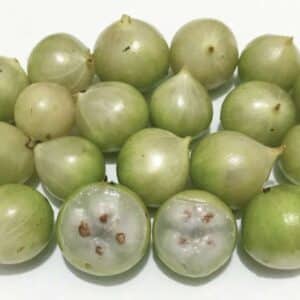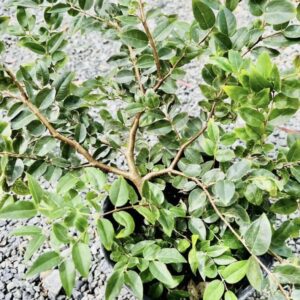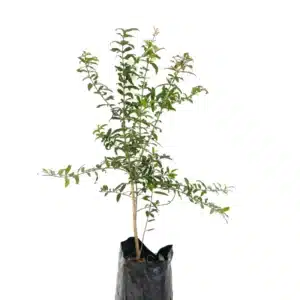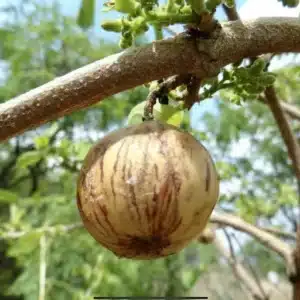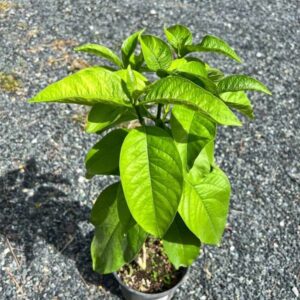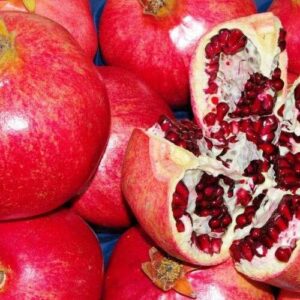White Jaboticaba (Plinia cauliflora) Tropical Living Fruit Tree 12” inches
White Jaboticaba Jaboticaba, also known as Brazilian grape tree, is a fruit tree native to Brazil that is now commonly grown in tropical and subtropical regions around the world. The tree produces small, grape-like fruits that are ligth green in color and have a sweet, juicy flesh. In this description, we will discuss how to plant and care for Jaboticaba trees, and some of the benefits they can provide.
An interesting fact about Jaboticaba trees is that they have a unique growth pattern. Unlike most fruit trees, which bear fruit on the ends of branches, Jaboticaba trees bear fruit directly on the trunk and larger branches. This means that the entire tree can be covered in fruit, creating a striking visual display. In addition, Jaboticaba trees have a relatively long lifespan, with some trees living for over 100 years. The combination of their unique growth pattern and longevity makes Jaboticaba trees a fascinating and rewarding addition to any garden or landscape.
Pomegranate Tropical Fruit Tree 24”-36”
Pomegranate is a fruit tree that is known for its striking appearance, with bright red fruit encasing juicy, ruby-colored seeds. The pomegranate tree is a drought-resistant plant that can grow up to 30 feet tall and wide, and can live for up to 200 years. In this description, we will discuss how to plant and care for a pomegranate tree, and some of the benefits it can provide. An interesting fact about pomegranates is that they have been revered throughout history for their medicinal properties. In ancient times, pomegranates were believed to have healing powers and were used to treat a variety of ailments, including infections, diarrhea, and even infertility. Modern research has shown that pomegranates are indeed a rich source of antioxidants and anti-inflammatory compounds, which may help to protect against chronic diseases such as heart disease and cancer. The juice of the pomegranate fruit has also been found to have antibacterial and antiviral properties, making it a valuable addition to a healthy diet.
The pomegranate tree (Punica granatum) is a versatile and rewarding plant that offers beauty, nutrition, and cultural significance. Its stunning flowers, hardy growth, and delicious fruits make it a favorite among gardeners and fruit enthusiasts alike. With proper care, including regular watering, fertilizing, and pruning, the pomegranate tree can thrive in a variety of climates and provide bountiful harvests for years to come. Whether grown for its ornamental appeal, culinary uses, or health benefits, the pomegranate tree is a timeless addition to any garden or orchard.
Spanish tamarind (vangueria madagascariensis) live fruit tree 12”-24” Irresistible
Vangueria madagascariensis, also known as Spanish Tamarind or Wild Medlar, is a tropical fruit tree native to Africa. It features an attractive, evergreen foliage with dark green, glossy leaves. The tree produces small, round fruits that ripen from green to yellow or orange when fully mature. Spanish Tamarind trees thrive in tropical and subtropical climates and require full sun to partial shade. With proper care, including regular watering, well-drained soil, and occasional fertilization, these trees can flourish and bear delicious fruits. The fruits are highly valued for their taste and are used in various culinary applications. In addition to its culinary uses, the Spanish Tamarind tree holds cultural significance in some African communities and is associated with spiritual beliefs and traditional ceremonies. Its ornamental appeal, fragrant flowers, and flavorful fruits make it an appealing addition to tropical gardens.
Pomegranate Live Tropical fruit Tree 12”-24”
Pomegranate is a fruit tree that is known for its striking appearance, with bright red fruit encasing juicy, ruby-colored seeds. The pomegranate tree is a drought-resistant plant that can grow up to 30 feet tall and wide, and can live for up to 200 years. In this description, we will discuss how to plant and care for a pomegranate tree, and some of the benefits it can provide. An interesting fact about pomegranates is that they have been revered throughout history for their medicinal properties. In ancient times, pomegranates were believed to have healing powers and were used to treat a variety of ailments, including infections, diarrhea, and even infertility. Modern research has shown that pomegranates are indeed a rich source of antioxidants and anti-inflammatory compounds, which may help to protect against chronic diseases such as heart disease and cancer. The juice of the pomegranate fruit has also been found to have antibacterial and antiviral properties, making it a valuable addition to a healthy diet.

